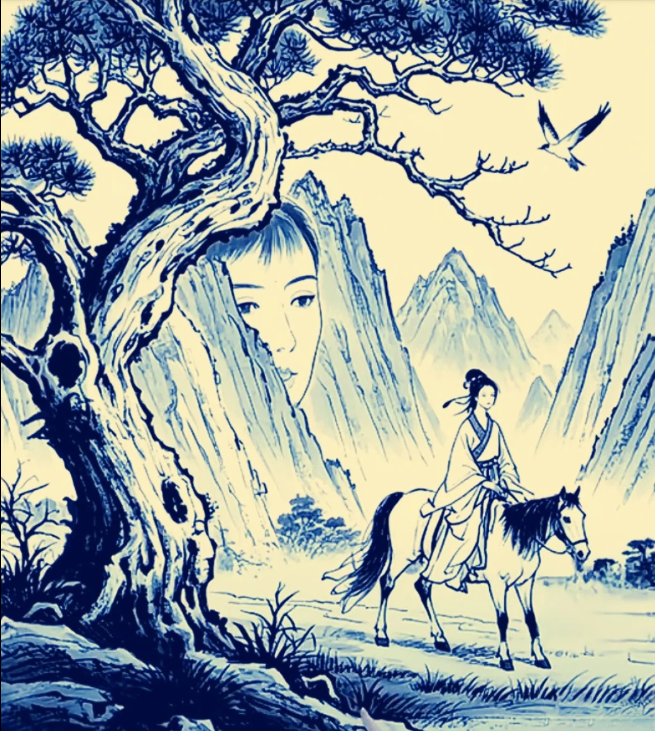Revealing the Hidden Maiden: The Art and Magic of Secret Faces in Chinese Landscape Painting
The Allure of Hidden Faces in Traditional Art
There’s a special thrill when you first notice the soft silhouette of a woman’s face emerging from ancient mountainside brushstrokes—especially in a scene painted in the timeless blue-and-white palette of Chinese ink wash traditions. Artists have woven secret images into landscapes for centuries, transforming static scenes into interactive puzzles that reward patient viewers. As you gaze at the elegant rider on horseback, framed by gnarled pines and jagged peaks, your eye will eventually discern a serene feminine visage nestled between rocky crevices. This hidden-maiden motif beckons us to slow down, look closer, and appreciate layers of meaning in every brushstroke.

Pareidolia and the Psychology of Hidden Images
Human brains naturally seek patterns, a phenomenon known as pareidolia. In art, creators exploit this tendency to:
- Engage Viewers: Sneaking a face into clouds or rocks invites onlookers to spend more time with the painting, savoring the “aha!” moment of discovery.
- Symbolize Unity: Blending human forms with nature suggests harmony between people and the landscape—a core theme in Daoist and Confucian aesthetics.
- Convey Mysticism: In Chinese folklore, mountain spirits often disguised themselves in rock formations; hidden faces evoke these legends.
Understanding pareidolia offers insight into why these subtle illusions remain so captivating across cultures and eras.
Roots in Chinese Landscape Painting: From Ink to Illusion
Landscape (山水, shān shuǐ) painting became a premier art form during the Tang (618–907) and Song (960–1279) dynasties. Masters like Fan Kuan and Guo Xi depicted towering peaks, knotted trees, and misty valleys in monochrome washes. Over time, artists introduced playful embellishments—birds shaped like dragons, paths suggesting calligraphy, and, most intriguingly, faces hidden within rocks or foliage. These secret elements served multiple purposes: showcasing technical prowess, layering symbolic meaning, and honoring folklore of 山鬼 (“mountain ghosts”) or benevolent spirits said to dwell in remote crags.

Decoding the Hidden Maiden in Our Scene
Take a closer look at the painting before you:
- The Mountain Profile: Notice the pale, vertical slab of rock behind the pine trunk. Its subtle curvature and delicate shading form the woman’s forehead, nose bridge, and lips.
- Hair and Headdress: Tiny clusters of leaf-like foliage crown the top of the face, mimicking traditional headdresses or flowing hair.
- Closed Eyes and Serenity: The eye appears as a soft, leaf-shaped gap between rocky ridges, imparting a tranquil, almost meditative expression.
- Integration with Nature: Rather than a pasted-in portrait, the maiden’s form seamlessly emerges from the mountain’s natural lines, reinforcing unity between humanity and the earth.
Spotting these details transforms the painting from a simple pastoral scene into a conversation between viewer, artist, and ancient cultural narratives.
Techniques for Spotting Hidden Faces in Landscape Art
Whether classic or contemporary, these tips will help you uncover more secret visages:
- Soft Gaze Over Sharp Focus: Relax your eyes and let the scene blur slightly—your brain will start to latch onto familiar outlines.
- Scan for Symmetry: Human faces thrive on balance. Look for vertical shapes that suggest two halves of a visage.
- Follow Contour Lines: Trees, ridges, and streams often double as hairlines or jaw edges. Trace these paths to reveal concealed profiles.
- Vary Viewing Distance: Step back and then approach again. Different scales highlight different patterns.
- Spotlight Dark–Light Contrasts: Hidden eyes and mouths tend to be darker indentations or lighter highlights against shadowy background.
By practicing these strategies, you’ll decode hidden imagery in landscapes by artists worldwide.

Cultural Significance of Hidden Figures in Asian Art
Hiding faces and figures in nature scenes resonates deeply in East Asian philosophies:
- Daoist Harmony: Daoism celebrates the seamless flow between humans and the cosmos. A hidden face in a mountain suggests that people are an integral, yet modest, part of nature’s grand design.
- Confucian Morality: Subtlety and restraint—valued Confucian virtues—shine through in artworks that reward respectful contemplation rather than loud spectacle.
- Literati Tradition: Scholar-artists of the Ming (1368–1644) and Qing (1644–1912) dynasties often added cryptic elements to demonstrate erudition and spark intellectual discourse among peers.
- Folk Beliefs: Legends of mountain spirits, river nymphs, and tree guardians populate Chinese folklore. Hidden faces pay homage to these unseen protectors of the natural world.
These cultural layers enrich the viewer’s experience, making each discovery both aesthetic and philosophical.

Bringing Hidden-Face Techniques into Your Own Art
Eager to weave your own secret profiles into landscapes? Here’s how:
- Start with Strong Silhouettes: Paint or draw a bold mountain ridge or tree trunk, then sketch a subtle profile shape within those lines.
- Play with Ink Wash and Negative Space: Chinese brush artists often leave parts of the paper blank to suggest mist or water. Use unpainted areas to form facial contours.
- Balance Detail and Suggestion: Too much detail gives the face away immediately; too little, and viewers may miss it. Aim for just enough shading to hint at eyes or lips.
- Experiment with Color: While traditional landscapes use ink, you can explore delicate color washes—blues, greens, earth tones—to enhance mood and concealment.
- Invite Interaction: Present your work to friends before revealing the secret. Their search process offers feedback on visibility and subtlety.
Through these practices, you’ll cultivate both technical skill and the playful spirit that makes hidden-face art so rewarding.

Conclusion: The Everlasting Magic of Secret Faces
Hidden faces in Chinese landscape paintings offer more than optical tricks—they invite us into a world where humans and nature merge, where folklore whispers through mountain mists, and where each careful brushstroke holds a secret waiting to be found. By understanding the psychology of pareidolia, studying historical contexts, and applying targeted spotting techniques, you can both appreciate these masterful illusions and create your own. Next time you stand before a rugged peak or a swaying pine, remember to look twice—nature’s hidden maidens may be watching you, ready to reveal themselves to the curious eye.





